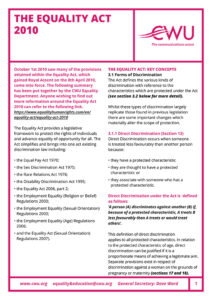The Equality Act 2010
 The Equality Act 2010 came into force on 1 October 2010.
The Equality Act 2010 came into force on 1 October 2010.
It brings together over 116 separate pieces of legislation into one single Act, which in theory should make it easier to use.
It sets out the personal characteristics that are protected by the law and the behaviour that is unlawful.
The nine ‘protected characteristics’ are: age, disability, gender reassignment, marriage and civil partnership, pregnancy and maternity, race, religion or belief, sex and sexual orientation.
Simplifying legislation and harmonising protection for all of the characteristics covered, it is also designed to help Britain become a fairer society, improve public services, and from a trade union perspective, give workers more robust protection at work.
The nine main pieces of legislation that have been merged are:
- Equal Pay Act 1970
- Sex Discrimination Act 1975
- Race Relations Act 1976
- Disability Discrimination Act 1995
- Employment Equality (Religion or Belief) Regulations 2003
- Employment Equality (Sexual Orientation) Regulations 2003
- Employment Equality (Age) Regulations 2006
- Equality Act 2006, Part 2
- Equality Act (Sexual Orientation) Regulations 2007
For more detailed information on the Equality Act, please read our Equality Act 2010 factsheet.



